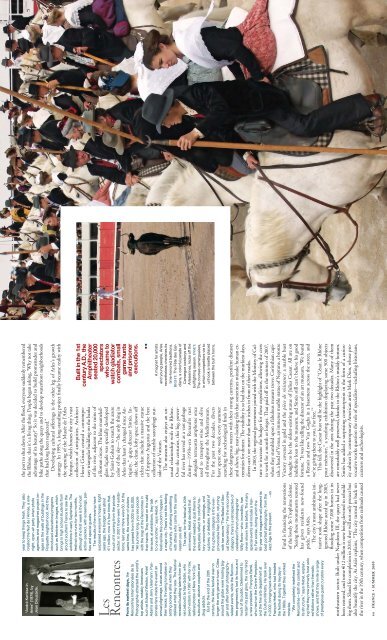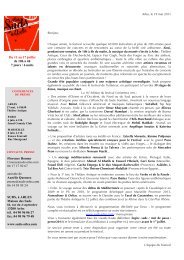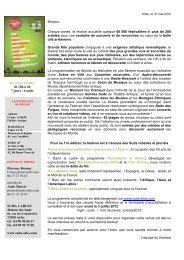GEO correspond-il à vos attentes ? - Les Suds à Arles
GEO correspond-il à vos attentes ? - Les Suds à Arles
GEO correspond-il à vos attentes ? - Les Suds à Arles
Create successful ePaper yourself
Turn your PDF publications into a flip-book with our unique Google optimized e-Paper software.
the port to shut down. After the flood, everyone suddenly remembered<br />
the Rhône, that it’s a living thing. People began asking, ‘Why not take<br />
advantage of its beauty?’ So it was decided to bu<strong>il</strong>d promenades and<br />
bike paths along the quays and to develop waterfront neighborhoods<br />
that had long been neglected.”<br />
Developing cultural offerings is the other leg of <strong>Arles</strong>’s growth<br />
strategy. In 1995, a long-standing project finally became reality with<br />
the opening of the Musée de l’<strong>Arles</strong><br />
Antique, which houses the city’s vast<br />
collection of antiquities. Architect Bu<strong>il</strong>t in the 1st<br />
Henri Ciriani created a contempo- century A.D., the<br />
rary triangular bu<strong>il</strong>ding on the banks Amphitheater<br />
of the river, adjacent to the ruins of seated 20,000<br />
a Roman circus. The blue enameled-<br />
spectators<br />
glass façade was specially developed who came to<br />
by Saint-Gobain to match the azure watch gladiator<br />
color of the sky—“the only thing in combats, small<br />
<strong>Arles</strong> that hasn’t changed since An-<br />
game hunts<br />
tiquity,” quips director Sintès. In-<br />
and prisoner<br />
side, the clean, lofty space shows off<br />
executions.<br />
riches that include a massive statue<br />
of Emperor Augustus and the best<br />
collection of marble sarcophagi out-<br />
A magnet for artists<br />
side of the Vatican.<br />
and young people, <strong>Arles</strong><br />
The museum also enjoys an un-<br />
nevertheless cherishes its<br />
usual relationship with the Rhône.<br />
time-honored traditions.<br />
right: The Fête des Gar-<br />
Over the centuries, this big, powerdians,<br />
a colorful parade of<br />
ful river has served as a vast garbage<br />
Camargue cowboys and<br />
dump—1950s-era Renaults rust<br />
<strong>Arles</strong>iennes, kicks off the<br />
alongside terracotta amphorae once<br />
bullfighting season. inset:<br />
The courses camarguaises,<br />
used to transport wine and olive<br />
in which competitors vie to<br />
o<strong>il</strong> throughout the Mediterranean.<br />
unhook a rosette placed<br />
For the past two decades, divers<br />
between the bull’s horns.<br />
have spent one week every summer<br />
searching for archeological finds in<br />
these dangerous waters with their strong currents, pest<strong>il</strong>ent diseases<br />
and s<strong>il</strong>ures, big, nasty-looking fish that sometimes mistake human extremities<br />
for dinner. The visib<strong>il</strong>ity is so bad that on the murkiest days,<br />
divers can’t see more than four inches in front of their masks.<br />
In 2003, the regional government joined with the Ministry of Culture<br />
to increase the budget for these expeditions, allowing the crew<br />
to work for a month or longer. That paid off in the summer of 2007,<br />
when they stumbled upon a fabulous treasure trove: Corinthian capitals,<br />
a head of Venus, an immense marble statue of Neptune, a bronze<br />
Victory covered in gold and the pièce de résistance: a marble bust<br />
thought to be the oldest-existing statue of Julius Caesar. All are on<br />
indefinite loan to the museum, and Sintès st<strong>il</strong>l can’t believe his good<br />
fortune. “It was like telling the director of an art museum, ‘We found<br />
a Renoir and two Van Goghs in a basement across the street, and<br />
we’re giving them to you. For free.’”<br />
This fall, the Caesar bust w<strong>il</strong>l be the highlight of “César, le Rhône<br />
pour mémoire,” a yearlong exhibition displaying some 500 objects<br />
discovered in the area during the past two decades. Many of them<br />
are remarkably well preserved, thanks to the Rhône’s muddy bottom.<br />
Sintès has added a surprising counterpoint in the form of a curiosity<br />
cabinet by contemporary American artist Mark Dion, whose provocative<br />
works question the role of specialists—including historians,<br />
curators and archeologists.<br />
year to keep things fresh. They also<br />
created the Nuit de l’Année, a onenight,<br />
open-air party when photo<br />
agencies and magazines project images<br />
on the walls of bu<strong>il</strong>dings in the<br />
Roquette neighborhood. And they<br />
introduced educational programs<br />
such as Rentrée en Images, which<br />
brings in high school students from<br />
around southern France to see the<br />
exhibitions in early September. The<br />
festival now runs for two months,<br />
although the first week is the most<br />
action-packed, with screenings, parties<br />
and special guests.<br />
The results of the revamp have<br />
surpassed everyone’s hopes. Eight<br />
years ago, the budget was about<br />
E1 m<strong>il</strong>lion; now it’s four times that,<br />
much of it coming from the private<br />
sector. In 2001 there were 14 exhibitions;<br />
last year there were 60. At the<br />
same time, the number of visitors<br />
has jumped from 9,000 to 60,000.<br />
“All summer long, you see people<br />
with the map of the Rencontres in<br />
their hands. They meet on the café<br />
terraces, at exhibitions, they talk<br />
to one another,” says Hebel. “A<br />
festival like this couldn’t happen in<br />
a major city. There’s not this feeling<br />
of humanity, of sharing something<br />
with others who came for the same<br />
reason you did.”<br />
This year, for the festival’s 40th<br />
anniversary, Hebel decided that<br />
the event needed a dual theme to<br />
adequately reflect its colorful history:<br />
rencontres, or meetings, and<br />
ruptures, or debates. A highlight of<br />
the ruptures category is the everprovocative<br />
Nan Goldin, returning<br />
with her oeuvre “The Ballad of Sexual<br />
Dependency.” For the rencontres<br />
category, there’s a retrospective of<br />
celebrated French photographer<br />
W<strong>il</strong>ly Ronis—who, incredibly, has<br />
never shown here before. The many<br />
special events w<strong>il</strong>l include a Vanity<br />
Fair soirée, during which the<br />
95-year-old magazine w<strong>il</strong>l present its<br />
best portrait photography, from the<br />
Jazz Age to the present. —AS<br />
“André Kertész in<br />
<strong>Arles</strong>” (1979), by<br />
Jean Dieuzaide.<br />
<strong>Les</strong><br />
Rencontres<br />
Fund is financing the renovations<br />
of the lovely St-Trophime cloister.<br />
“Seeing these monuments restored<br />
has given residents new-found<br />
pride,” says Ariès.<br />
The city’s most ambitious initiative<br />
took shape after the longignored<br />
Rhône acted up in 2003,<br />
flooding some 7,000 homes in its<br />
From its earliest days, the<br />
Rencontres Internationales de la<br />
Photographie attracted the world’s<br />
top artists, notably Americans<br />
such as Edward Weston, Ansel<br />
Adams and Jerry Uelsmann. Passionate<br />
fans made the event an<br />
annual p<strong>il</strong>grimage, Leicas around<br />
their necks, throwing tomatoes or<br />
setting screens afire when they<br />
disliked what they saw. The festival<br />
revealed budding talents from Annie<br />
Liebovitz to Nan Goldin, who<br />
awed visitors in 1987 with her raw,<br />
radical photos of New York City<br />
subculture, abusive couples and<br />
drug addicts.<br />
But by the end of the 20th<br />
century, the <strong>Arles</strong> festival was no<br />
longer the only game in town. Cities<br />
around the globe were hosting bigger<br />
and often better photographyrelated<br />
events, wh<strong>il</strong>e the Rencontres<br />
progressively lost its focus and<br />
much of its public. Determined to<br />
reclaim its past glory, the city hired<br />
a new president, François Barré,<br />
who had run the Centre Pompidou<br />
and the fine arts department at<br />
the Culture Ministry. He took over<br />
in 2002, bringing back director<br />
François Hebel, who had headed<br />
the festival during its heyday in<br />
the 1980s. Together they worked<br />
miracles.<br />
“We completely redefined the<br />
Rencontres—both its content and<br />
its structure,” says Hebel, explaining<br />
that they now primar<strong>il</strong>y host solo<br />
exhibitions rather than thematic<br />
shows, and that they invite a range<br />
of prestigious guest curators every<br />
northeastern sector. Bu<strong>il</strong>t under Napoleon III, the quays had never<br />
been restored, and some €12 m<strong>il</strong>lion is now being devoted to rebu<strong>il</strong>ding<br />
them. Slated for completion in 2010, they w<strong>il</strong>l not only protect but<br />
also beautify the city. As Ariès explains, “The city turned its back on<br />
the river in the 19th century, when competition from ra<strong>il</strong>roads caused<br />
44 France • summer 2009





